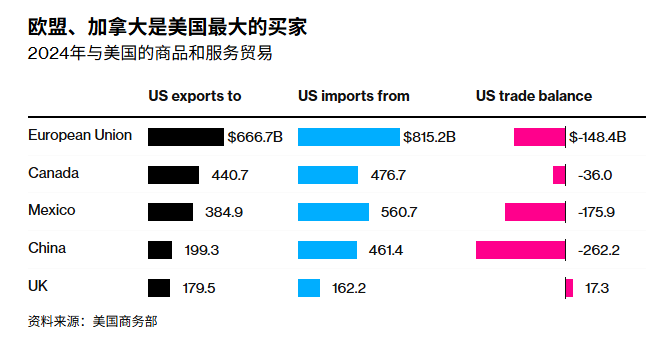After a series of new threats from the EU and other US trading partners, informed sources revealed that the EU is preparing to enhance its engagement with other countries affected by Donald Trump’s tariffs.
People familiar with the matter said that contacts with countries such as Canada and Japan could include the possibility of coordination. Because the discussions involved were private, these people requested anonymity.
At present, negotiations between the EU and the US have been dragging on and have reached a deadlock on several issues, including tariffs on automobiles and agriculture.
On Sunday, member states were briefed on the progress of the talks.

Earlier in the day, European Commission President Ursula von der Leyen said the EU would extend the suspension of its trade countermeasures against the US until August 1 to allow for further negotiations. These measures were taken in response to the tariffs imposed by Trump on steel and aluminum earlier and had been suspended before, with the original plan to resume them at midnight on Tuesday.
At the same time, we will continue to prepare further countermeasures to be fully prepared, von der Leyen told reporters in Brussels on Sunday. She also reaffirmed that the EU prefers a “negotiated solution”.
People familiar with the matter said that the current list of countermeasures will impose tariffs on about 21 billion euros (24.5 billion US dollars) worth of US goods, while the EU has prepared another list of countermeasures worth about 72 billion euros and some export control measures, which will be submitted to member states as early as Monday.
Von der Leyen also said that the EU’s most powerful trade tool – the anti-coercion mechanism – would not be activated for now. “The anti-coercion mechanism was established to deal with exceptional circumstances,” she said. “We are not at that stage yet.”
French President Emmanuel Macron responded to Trump’s statement on social media, calling for the acceleration of preparations for reliable countermeasures, including anti-coercion tools, if an agreement cannot be reached by August 1.
German Chancellor Friedrich Merz said on Sunday evening that a 30% tariff would deal a “fundamental” blow to exporters in Europe’s largest economy if the trade conflict could not be resolved through negotiations.
Merkel said she was closely coordinating with other leaders to ensure that such high tariffs would not come into effect. The conservative leader told ARD in an interview: “This requires two things: unity within the EU and good communication with the US president.”
Sven Jari Stehn, an economist at Goldman Sachs, wrote in a report that the proposed 30% tariff rate, combined with existing industry tariffs and expected tariffs on key goods, would raise the actual tariff rate of the United States on the EU to 26 percentage points. If this policy is implemented and sustained, the eurozone’s GDP will have cumulatively declined by 1.2% by the end of 2026, and most of the shock has yet to come.
Goldman Sachs economists wrote: “The EU may gradually retaliate with a 30% full tariff from the date the new US tariffs are implemented, which will increase the risk of further escalation of the trade war.” However, the latest threat “is likely a negotiating tactic”, so the economists stick to their basic prediction that both sides will agree to maintain the current tariff levels, including a 10% tariff on all goods and a 25% tariff on steel, aluminum and automobiles.
Trump has written to many trading partners, adjusting the tariff levels proposed in April and inviting them to further negotiations. In a letter released on Saturday, the US president warned the EU that if better terms could not be reached, the bloc would face a 30% tariff from next month.
Trump told reporters at Joint Base Andrews in Maryland on Sunday that the European Union is negotiating with the United States on trade issues.
The EU had sought to reach a preliminary agreement with the US to avoid tariff hikes, but Trump’s letter dashed Brussels’ recent optimism about the prospects of a last-minute deal. Other countries that have been negotiating with the US, such as Mexico, were also taken aback by receiving similar letters.
The EU is seeking to impose a tariff of no more than 10% on agricultural exports. Some automakers had advocated for a compensation mechanism aimed at providing tariff relief for businesses investing in the US, but this has not been considered as the EU is concerned that it might lead to production being shifted across the Atlantic.
According to informed sources, EU negotiators are currently focusing on discussing the issue of auto tariffs. These sources requested anonymity as the discussions were held in private.
According to a previous report by Bloomberg, the United States and the European Union have been discussing a preliminary agreement that would impose a 10% tariff on most of the EU’s exports, with limited exemptions for certain industries such as aviation and medical devices. The EU also advocates for a reduction in tariffs on spirits and wine and a quota system to alleviate the 50% tariffs imposed by Trump on steel and aluminum. The US, on the other hand, proposes a 17% tariff on agricultural products. Any preliminary agreement would also cover non-tariff barriers, economic security cooperation, and strategic procurement.
In addition to the universal tax that will take effect in August, Trump has imposed a 25% tax on automobiles and auto parts and a double tax on metals. The president is striving to introduce industry taxes in other fields including pharmaceuticals and semiconductors and recently announced a 50% tariff on copper.
Any agreement reached at this stage will not automatically exempt the EU from these industry measures, but the EU is still seeking preferential treatment for industries that may be affected.


